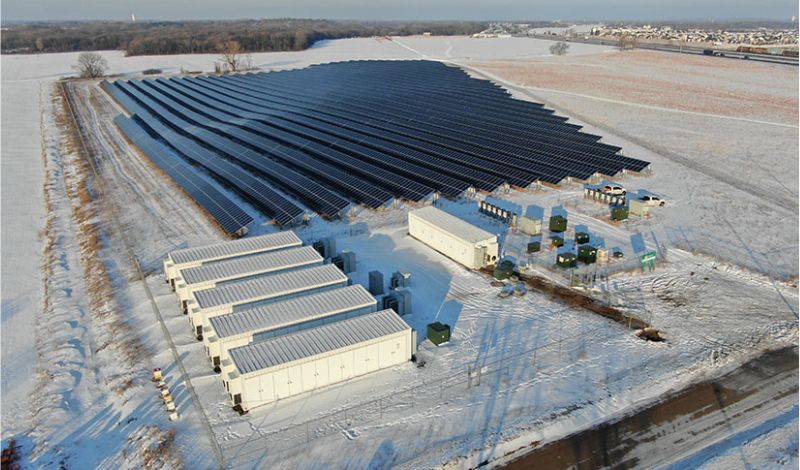NREL Demo Automates Power Outage Recovery
The National Renewable Energy Laboratory combines several types and sources of grid data to automate the power recovery process in rural co-ops.
Colorado’s National Renewable Energy Laboratory (NREL) is launching a demonstration project to automate power outage recovery processes in rural areas subject to extreme cold, forest fires, and heavy snow. Backed by U.S. Department of Energy funding and participation from rural co-ops, the project will infuse solar, storage, and sensor technologies to identify and isolate power outages.
Connexus Energy’s solar plus battery storage facility in Ramsey, Minnesota. Image used courtesy of NREL
The Solar-HERO project (short for Solar-Assisted, Stakeholder-Engaged Autonomous Restoration with Data Orchestration) will draw information from power lines, environmental data, and connected devices to provide a more comprehensive set of situational awareness resources for utilities and response teams. Focusing on automation, the project is expected to yield methods to improve grid resilience—a point of growing demand among utility companies.
Solar-HERO teamed up with rural cooperative utilities that often deal with forest fires, snowstorms/blizzards, and high winds. The partner co-ops include Colorado-based Holy Cross Energy and United Power, each serving 45,000 and 300,000 members, respectively, and Minnesota’s Connexus Energy, one of the largest co-ops in the Midwest, with 144,000 members.
Solar-HERO Project Scope
According to NREL, Solar-HERO will use commercially available technologies from a group of partners alongside the latest research developments from NREL itself. Contributors include:
-
Electrical Grid Monitoring, a California-based company providing transmission and distribution grid management systems, will contribute a Meta-Alert System to measure more than 60 parameters of electrical, physical, and environmental data points.
-
NEC Laboratories America, a U.S.-based subsidiary of Japanese electronics giant NEC Corporation, will supply its distributed fiber-optic sensing system, capable of monitoring conditions around power lines at 1-meter resolution.
-
SurvalentONE, an advanced distribution management system (ADMS) from Canada-based Survalent, will explore how the datasets can work with outage data and conventional grid visibility functions.
-
Copper Labs, a Colorado-based firm whose solutions collect real-time data from electric, gas, and water meters, will use its grid-edge sensors to measure energy devices every 30 seconds.
-
Camus Energy, a California company providing a grid management software platform, will gather all partner device data (and data from customer-owned solar and storage installations) and incorporate it with Survalent’s ADMS to gauge how much flexibility is free for recovery/restoration.
-
DataCapable, which markets an AI-powered event detection platform for emergency management and public safety customers, will screen relevant live data from online forums and social feeds.
Finally, NREL will synthesize all that data to provide real-time resilience states.
The Solar-HERO project aims to demonstrate how inverter-based resources can reconfigure into new electrical islands and stay live during disruptions. NREL will also work to demonstrate its grid-forming controls. Iowa State University will develop an optimized service restoration scheme designed to maintain grid stability while shifting microgrid configurations.
Grid Resilient Technology Demand
The NREL’s project comes as the demand for grid resilience technologies is at an all-time high, as utilities across the country brace for summer heatwaves and other extreme weather events likely to come later this year.
The rural co-ops involved in Solar-HERO will use the data to inform strategies to install new sensors and controls to improve their uptime and reliability.
United Power’s 4-megawatt, Tesla-powered battery storage project launched in 2018 as the largest-of-its-kind facility in Colorado. Image used courtesy of United Power
All three co-ops have stepped up their efforts in recent years. United Power implemented a targeted maintenance process in 2017 that reduced its outage times to under 70 minutes per meter—down from the national average of 120 minutes per meter in a year. Connexus’s resilient grid design means its members experience an unplanned outage once every 3.6 years. Meanwhile, Holy Cross Energy has taken steps to expand its wildfire mitigation processes.








